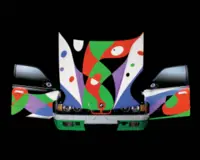BMW's Jack Pitney on Art, Architecture, and Cars
 |
by Marty Bernstein
AIADA Contributing Editor
Conversations with Jack Pitney — BMW North America’s vice president of marketing and product development and the man who introduced the new MINI to America — are always informative and insightful.
I had the opportunity to speak with Pitney recently during a lengthy on-the-record lunch, following the media preview of the company’s Art Car installation in New York’s world famous Grand Central Station. The station is known for many things, but a showcase for art, much less automobiles, is not one of them. I asked Pitney, “Why Grand Central?”
Pitney explained that BMW is well known for its engineering excellence. But what many don’t know is that the company uses its commitment to contemporary art and architecture as an important “aspect of our corporate culture, and a marketing tool.”

Citing the exhibit, in which four of the sixteen BMW Art Cars created by some of the most prominent artists in the world were on display, Pitney said “Rather than canvas, they’ve painted their artistic creations on the sheet metal of BMWs — both racing and regular production models.”
Earlier in the day, during a media conference, BMW introduced cinema-video art created for the German automaker by contemporary South African artist Robin Rhode, British filmmaker Jake Scott, and two new BMW Z4 roadsters specially equipped with paint spray nozzles on their wheels.
Following the paths established, and spraying colors determined by Rhode, the roadsters drove on a football-field size canvas painting, while Scott captured all the action with 40 simultaneous camera angles. Colors morphed in an amazing, vibrant work of contemporary art. “How does this art fit into your marketing plans?” I asked Pitney.
“We wanted an innovative approach for the launch of the new Z4,” he answered, “The final Rhode piece and video elements form the foundation of the campaign’s creative treatments.”
The result is an aesthetically powerful marketing campaign entitled "Expression of Joy," which rolled out in May. The campaign, which relies heavily on vibrant video content, includes a 30-second television commercial and a 30-minute documentary.
“BMW has a long history of collaborating with contemporary artists,” said Pitney. “Through this latest collaboration with Robin and Jake, we’ve extended our tradition of engaging leading talents in the art community for the introduction of the all-new BMW Z4 Roadster."
BMW’s use of culture — specifically contemporary art and architecture — goes beyond marketing; it is also a subliminal motivating stimulus. Pitney commented, “We are of the belief that inspiring design inspires people.”

BMW’s commitment began in 1972 with Gerhard Richter’s commission of three large-scale paintings for the foyer of the company headquarters in Munich. Critics described the corporate headquarters as “a post-war icon, designed by architect Karl Schwinger’s, the ‘four-cylinder’ building, which marked the beginning of the company’s emphasis on an innovative, dynamic style of construction.”
According to Pitney, this contemporary art and architecture, especially the art cars, has a corporate benefit. “These are the jewels of our brand and are treated in that manner,” he said. “These cars will be around long after we’re gone, that’s why we treat them as precious assets. That is why we display them in a historic location like this in one of the greatest cities in the world. A hundred years from now, there will be some BMW marketing guy doing an interview in this setting and will be talking about his collection of art cars. By then, maybe we will have 50 in the collection.”
Finally, I asked Pitney to give me a sound-bite-summary. He thoughtfully responded, “Whether art and design inspires our people to build a better quality product in our Leipzig factory, or whether it’s creating something like the BMW Welt, our delivery center in Munich, or participating in things like this Art Car exhibit, it’s one of the interesting facets that make BMW such a remarkable company to work for. Because we do things that aren’t typical or required.”
Did commerce gain from culture or did culture gain from commerce? In this case, both are winners for BMW.



